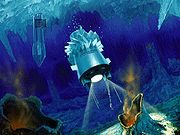
Cryobot
Encyclopedia


Robot
A robot is a mechanical or virtual intelligent agent that can perform tasks automatically or with guidance, typically by remote control. In practice a robot is usually an electro-mechanical machine that is guided by computer and electronic programming. Robots can be autonomous, semi-autonomous or...
designed to operate in or around water ice
Ice
Ice is water frozen into the solid state. Usually ice is the phase known as ice Ih, which is the most abundant of the varying solid phases on the Earth's surface. It can appear transparent or opaque bluish-white color, depending on the presence of impurities or air inclusions...
.
Features and technology
The cryobot is a surface-controlled, nonrecoverable instrumented vehicle that can penetrate polar ice sheets down to 3600 meters by melting. It can be used to measure temperature, stress, ice movement, and seismic, acoustic and dielectric properties. It can also be used for other investigations with remote instrumentation. The probe consists of a hot point for melt penetration, instrumentation for control and measurement functions, two supply conductor coils to link the probe with the surface for transmission of power and measurement signals, and a reservoir section. The probe is filled with a dielectric fluid.History
The cryobot was invented by German physicist Karl Philberth, who first demonstrated it in the 1960s as part of the International Glaciological Greenland Expedition (EGIG), achieving drilling depths in excess of 1,000 meters. In 1973 British scientists in Antarctica performed airborne ice-penetrating radarRadar
Radar is an object-detection system which uses radio waves to determine the range, altitude, direction, or speed of objects. It can be used to detect aircraft, ships, spacecraft, guided missiles, motor vehicles, weather formations, and terrain. The radar dish or antenna transmits pulses of radio...
survey and detected a possible lake. In 1991, the European remote sensing satellite ERS-1
European Remote-Sensing Satellite
European remote sensing satellite was the European Space Agency's first Earth-observing satellite. It was launched on July 17, 1991 into a Sun-synchronous polar orbit at a height of 782–785 km.-Instruments:...
confirmed the 1973 discovery of a large lake below four kilometers of ice, named Lake Vostok
Lake Vostok
Lake Vostok is the largest of more than 140 subglacial lakes found under the surface of Antarctica. The overlying ice provides a continuous paleoclimatic record of 400,000 years, although the lake water itself may have been isolated for 15 to 25 million years. The lake is named after the...
. The lake is thought to be uncontaminated. NASA was planning to use a cryobot to explore the lake, which is the fifth largest freshwater lake in the world. The lake may offer a glimpse into what types of microbes lived thousands of years ago as its ecosystem has been cut off from the outside world 15 million years ago. Cryobots have been tested in Antarctica as prototypes for a space probe that may someday penetrate the icy surface of Europa
Europa (moon)
Europa Slightly smaller than Earth's Moon, Europa is primarily made of silicate rock and probably has an iron core. It has a tenuous atmosphere composed primarily of oxygen. Its surface is composed of ice and is one of the smoothest in the Solar System. This surface is striated by cracks and...
, a moon of Jupiter
Jupiter
Jupiter is the fifth planet from the Sun and the largest planet within the Solar System. It is a gas giant with mass one-thousandth that of the Sun but is two and a half times the mass of all the other planets in our Solar System combined. Jupiter is classified as a gas giant along with Saturn,...
, and explore the liquid water ocean thought to be present below the ice, which may harbour extraterrestrial life
Extraterrestrial life
Extraterrestrial life is defined as life that does not originate from Earth...
.

